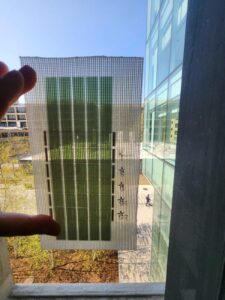Total Shade would like to introduce our flexible, roll-up PV Integrated window shades, Total Shade Solar Systems. Total Shade is actively exploring collaboration opportunities with an MIT spin-out, we have identified the market as large, multi-story commercial and residential buildings (skyscrapers). By making use of the significant protected surface area on the inside of urban high-rise buildings, we are able to unlock a vast resource of solar generation. For example, if the Willis Tower (formerly sears) in Chicago were PV enabled, it would be the equivalent to a 10 acre solar farm. Directly where the energy is needed.
We will integrate optical coatings/films to reject IR light, introduce millimeter-scale holes in the photovoltaic material for 5-10% of visible light to pass through, providing daylighting and an outdoor view even with the shades down. We will design the cell interconnection network and power electronics required to allow the window shade to operate at the maximum power point. We will improve manufacturability of the shades by developing a preliminary roll-to-roll process to produce the shades. We will develop a smart control system to automatically operate the shades to maximize the impact of the extreme SHGC modulation based on weather conditions. Finally, we will take advantage of advancements in perovskite cell technology to introduce flexible perovskite solar cells into the window shade, doubling the window shade power output. At the end of the project, we will demonstrate SHGC modulation of a window with our window shade from a low of less than zero to a high of at least 0.75.
There are several technical risks associated with the proposed work. To mitigate these risks, our plan takes advantage of our existing products and technology as much as possible and leverages other “off the shelf” technologies and techniques (e.g., the smart control system will use existing cloud-based tools to determine local weather conditions and the power electronics used for the prototypes will be existing micro-inverters or power optimizers). The highest risk element in the proposed work is the incorporation of perovskite solar cells, however, the benefit would be significant. Given the rapid rate of maturation of perovskite cells, we believe the best approach to mitigate this risk is to use a go/no-go decision point on this task. If there is a flexible perovskite cell technology that can be adopted with minimal risk when we need it, we will launch that task, otherwise we will continue development with amorphous silicon. 3.0 Impact The proposed PV window shade will provide the highest SHGC modulation ever demonstrated. It will be constructed using materials and technologies that are economical and scalable, allowing a clear pathway to commercialization with a cost similar to the current ~$1000 cost for high-end commercial window shades that are commonly installed. If implemented in both commercial and residential buildings across the US, we estimate that the energy savings would be at least one quad annually. The proposed technology is a high-risk/high-reward effort. The availability of EERE funds to pursue the proposed R&D will be necessary to reduce risk to the point where private investment would become available for full commercialization<

The primary benefit of a Total Shade Solar System is the ability to generate an impressive amount of solar energy on-site. The secondary benefit is a direct reduction in solar heat gain across the envelope of the entire building.
From the DOE Building Technology Office, “President Biden has called for net-zero emissions, economy-wide, by 2050 and a 100% clean energy electricity sector by 2035. Within the building sector, the Biden Administration has set the goal to make zero emissions resilient new construction and retrofits common practice by 2030.” This gives us great confidence in the direction of the DOE with regard to building technology moving into the future. We feel that Total Shade Systems can be an integral part to bringing zero emissions to a reality.

